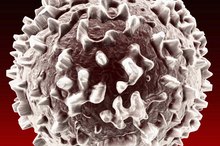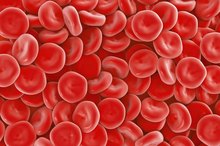Causes of Low Platelet Count & Abnormal White Blood Cells
Platelets and white blood cells are two of the main blood cell types in the body. Abnormal levels of these cells can be a sign of illness, disease or complications. Thrombocytopenia, or a low platelet count, can have serious consequences because platelets are required for blood clotting, and excess bleeding can occur if levels are decreased 2. A healthy platelet count is 150,000 or higher. Leucopenia or low white blood cell count is a decrease in leukocytes in the blood 3. White blood cells are important disease-fighting cells in the immune system, and low levels can cause infection and illness. Causes of low platelets and white blood cells include illness, disease, medication side effects and complications of cancer treatments.
If you are experiencing serious medical symptoms, seek emergency treatment immediately.
Enlarged Spleen
Decreased platelet counts can occur due to an unhealthy and enlarged spleen. MayoClinic.com explains that the spleen is normally an important infection-fighting and blood filtering organ, but if it becomes enlarged it may trap too many platelets 234. This causes a decrease in the number of platelets in circulating blood, leading to serious bleeding disorders. As platelets live for only 10 days, the body is not able to produce enough to keep the platelet count high enough.
- Decreased platelet counts can occur due to an unhealthy and enlarged spleen.
- MayoClinic.com explains that the spleen is normally an important infection-fighting and blood filtering organ, but if it becomes enlarged it may trap too many platelets 2.
Infection
The Effects of Low White Blood Cells on Healing After Surgery
Learn More
An infection, particularly viral and parasitic infections, can decrease white blood cell counts by destroying cells and damaging bone marrow, where blood cells are produced. Platelets are also produced in the bone marrow, and MayoClinic.com notes that the production of these cells is also suppressed by infection, leading to low platelet counts 234. A severe bacterial or viral and parasitic infection in the blood can also cause the destruction of platelets.
Chemotherapy
Chemotherapy cancer treatment is used to suppress rapidly multiplying cancer cells, but it can also damage healthy cells 4. When the bone marrow is affected, production of both white blood cells and platelets can be hindered, leading to decreased levels in the body. However, as MayoClinic.com notes, the effects of chemotherapy on bone marrow and other healthy organs are temporary, and platelet and white blood cell production return to normal levels some time after treatment is stopped 234.
Autoimmune Diseases
What Are the Causes of Low Platelets & Low White Blood Cells?
Learn More
Autoimmune disorders occur when the body’s immune system attacks its own healthy tissue. This can decrease white blood cell and platelet counts in the body. If the disease targets bone, it can also damage the bone marrow and hinder the production of blood cells. Examples of common autoimmune diseases include allergies, rheumatoid arthritis and lupus.
- Autoimmune disorders occur when the body’s immune system attacks its own healthy tissue.
- If the disease targets bone, it can also damage the bone marrow and hinder the production of blood cells.
Related Articles
References
- London Health Sciences Center: Low Platelets
- MayoClinic.com: Low White Blood Cell Count
- MayoClinic.com: Cancer Treatment
- Auerbach M, Adamson JW. How we diagnose and treat iron deficiency anemia. Am J Hematol. 2016;91(1):31-38. doi:10.1002/ajh.24201
- Penn State Hersey. Milton S. Hersey Medical Center. CBC Blood Test. Updated October 24, 2018.
- Whitehead L. Managing Chemotherapy-Induced Anemia with Erythropoiesis-Stimulating Agents Plus Iron. Am J Nurs. 2017;117(5):67. doi:10.1097/01.NAJ.0000516277.58981.36
- Mohandas H, Jaganathan SK, Mani MP, Ayyar M, Rohini Thevi GV. Cancer-related fatigue treatment: An overview. J Cancer Res Ther. 2017;13(6):916-929. doi:10.4103/jcrt.JCRT_50_17
- Long B, Koyfman A. Oncologic Emergencies: The Fever With Too Few Neutrophils. J Emerg Med. 2019;57(5):689-700. doi:10.1016/j.jemermed.2019.08.009
- Bond TC, Szabo E, Gabriel S, et al. Meta-analysis and indirect treatment comparison of lipegfilgrastim with pegfilgrastim and filgrastim for the reduction of chemotherapy-induced neutropenia-related events. J Oncol Pharm Pract. 2018;24(6):412-423. doi:10.1177/1078155217714859
- National Heart, Lung, and Blood Institute. Thrombocytopenia. 2019.
- Kuter DJ. Managing thrombocytopenia associated with cancer chemotherapy. Oncology (Williston Park). 2015;29(4):282-294.
- Sunkesula VC, Knighton S, Zabarsky TF, Kundrapu S, Higgins PA, Donskey CJ. Four Moments for Patient Hand Hygiene: A Patient-Centered, Provider-Facilitated Model to Improve Patient Hand Hygiene. Infect Control Hosp Epidemiol. 2015;36(8):986-989. doi:10.1017/ice.2015.78
Writer Bio
Noreen Kassem is a hospital doctor and a medical writer. Her articles have been featured in "Women's Health," "Nutrition News," "Check Up" and "Alive Magazine." Kassem also covers travel, books, fitness, nutrition, cooking and green living.








